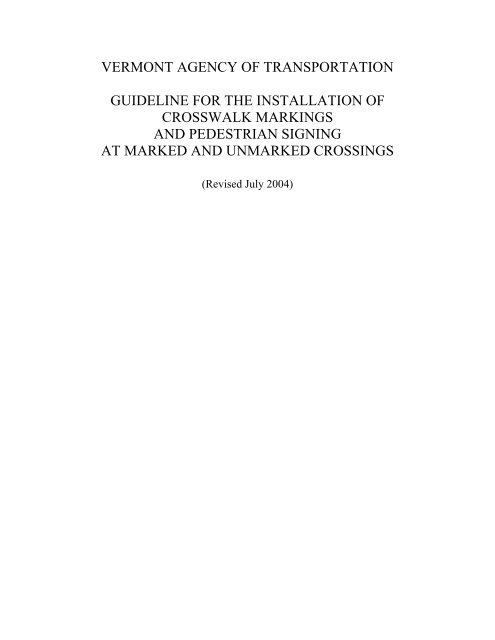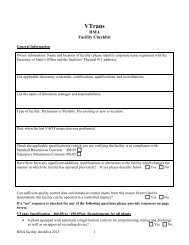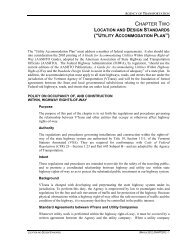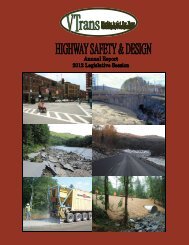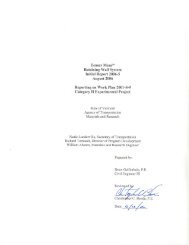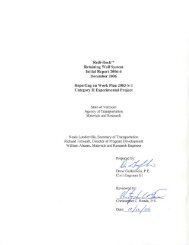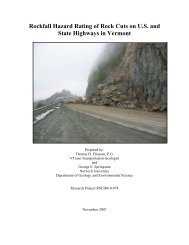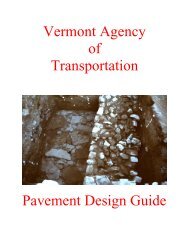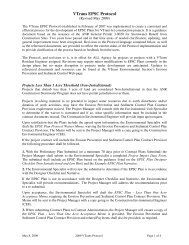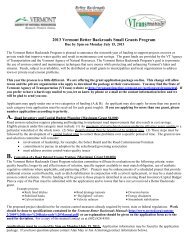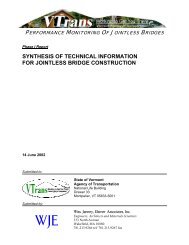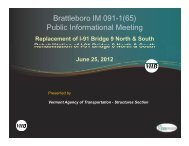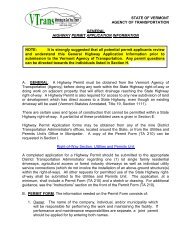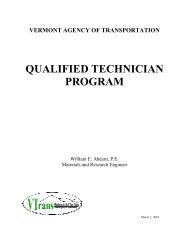Crosswalk Guidelines - Vermont AOT Program Development
Crosswalk Guidelines - Vermont AOT Program Development
Crosswalk Guidelines - Vermont AOT Program Development
Create successful ePaper yourself
Turn your PDF publications into a flip-book with our unique Google optimized e-Paper software.
VERMONT AGENCY OF TRANSPORTATION<br />
GUIDELINE FOR THE INSTALLATION OF<br />
CROSSWALK MARKINGS<br />
AND PEDESTRIAN SIGNING<br />
AT MARKED AND UNMARKED CROSSINGS<br />
(Revised July 2004)
Table of Contents<br />
List of Figures.................................................................................................................... 2<br />
1.0 Introduction................................................................................................................. 3<br />
1.1 Use of Guideline: ............................................................................................ 3<br />
1.2 MUTCD Support and Guidance: .................................................................... 3<br />
1.3 <strong>Vermont</strong> Law: ................................................................................................. 4<br />
2.0 Design of Marked <strong>Crosswalk</strong>s ................................................................................... 7<br />
2.1 Pavement Markings: ....................................................................................... 7<br />
2.1.1 MUTCD Standards and Guidance: ........................................................ 8<br />
2.2 Other Issues:.................................................................................................... 9<br />
2.2.1 ADA Compliance: ................................................................................... 9<br />
2.2.2 Shared-Use Paths: .................................................................................. 9<br />
2.2.3 Colored and Textured pavement:.......................................................... 10<br />
2.2.4 Use of Fluorescent Yellow-Green Signs:.............................................. 10<br />
2.2.5 In-street pedestrian crossing signs ....................................................... 11<br />
3.0 Marked <strong>Crosswalk</strong>s at Intersections....................................................................... 13<br />
3.1 Signalized Intersections: ............................................................................... 13<br />
3.1.1 Criteria for installation: ....................................................................... 13<br />
3.1.2 No parking zone:................................................................................... 13<br />
3.1.3 Pedestrian Warning Signs: ................................................................... 14<br />
3.2 Unsignalized Intersections – Stop or Yield Sign Controlled Approaches:... 14<br />
3.2.1 Criteria for installation: ....................................................................... 14<br />
3.2.2 Installation of Stop Bar:........................................................................ 15<br />
3.2.3 No parking zone:................................................................................... 15<br />
3.2.4 Pedestrian Warning Signs: ................................................................... 15<br />
3.3 Unsignalized Intersections – Roundabout: ................................................... 15<br />
3.3.1 Criteria for installation: ....................................................................... 15<br />
3.3.2 No parking zone:................................................................................... 16<br />
3.3.3 Pedestrian Warning Signs: ................................................................... 16<br />
3.4 Unsignalized Intersections – Uncontrolled Approaches:.............................. 16<br />
3.4.1 Criteria for installation: ....................................................................... 17<br />
3.4.2 No parking zone:................................................................................... 17<br />
3.4.3 Pedestrian Warning Signs: ................................................................... 18<br />
4.0 Marked <strong>Crosswalk</strong>s at Mid-Block Locations......................................................... 19<br />
4.1 School Crossings:.......................................................................................... 19<br />
4.1.1 Criteria for installation: ....................................................................... 19<br />
4.1.2 No parking zone:................................................................................... 20<br />
4.1.3 School Crossing Signs: ......................................................................... 20<br />
4.2 Non-School Crossings: ................................................................................. 21<br />
4.2.1 Criteria for installation: ....................................................................... 22<br />
4.2.2 No parking zone:................................................................................... 23<br />
4.2.3 Pedestrian Warning Signs: ................................................................... 23<br />
4.3 Stopping Sight Distance Chart:..................................................................... 24<br />
1
5.0 Unmarked Crossings ................................................................................................ 25<br />
5.1 Case A – Long Distance (150 m – 1.6 km (500 ft to 1 mile)): ..................... 25<br />
5.2 Case B – Short Distance (150 m (500 ft) or less): ........................................ 26<br />
5.3 Case C – Specific Site:.................................................................................. 27<br />
6.0 Glossary ..................................................................................................................... 28<br />
7.0 Resources and References ........................................................................................ 29<br />
List of Figures<br />
Figure 1: Allowable crosswalk marking patterns ............................................................. 7<br />
Figure 2: In-Street Pedestrian Crossing Sign................................................................. 11<br />
Figure 3: Traffic Signal Controlled Intersections ........................................................... 13<br />
Figure 4: Stop or Yield controlled approach................................................................... 14<br />
Figure 5: Roundabout approach...................................................................................... 15<br />
Figure 6: Uncontrolled intersection approach................................................................. 16<br />
Figure 7: School Crossing............................................................................................... 19<br />
Figure 8: Mid-Block Crossing ........................................................................................ 21<br />
Figure 9: Mid-block Bulbout Example........................................................................... 23<br />
Figure 10: Stopping Sight Distances............................................................................... 24<br />
Figure 11: Unmarked Crossings – Long Distance............................................................ 25<br />
Figure 12: Unmarked Crossings – Short Distance............................................................ 26<br />
Figure 13: Unmarked Crossings - Specific Site................................................................ 27<br />
2
1.0 Introduction<br />
1.1 Use of Guideline:<br />
The purpose of this guideline is to ensure that pedestrian crossings are treated<br />
consistently throughout the state, on both state highways and local roads, by providing<br />
guidance on the location of marked and unmarked crossings, and the associated pavement<br />
markings and signs.<br />
This guideline is intended to supplement the Manual on Uniform Traffic Control Devices<br />
(MUTCD), and conflicts between the two documents should defer to the latest edition of<br />
the MUTCD. References to sections of the MUTCD in this guideline correspond to the<br />
2003 Edition.<br />
This guideline is also intended to incorporate <strong>Vermont</strong> state law where applicable.<br />
Conflicts between this guideline and the latest statutes should defer to the statute.<br />
References in this guideline correspond to the 2004 Motor Vehicle Laws of <strong>Vermont</strong>.<br />
It must be recognized that not all situations can be adequately addressed in this guideline;<br />
therefore engineering judgment must be used at all times.<br />
The <strong>Vermont</strong> Pedestrian and Bicycle Facility Planning and Design Manual, published by<br />
VTrans, also contains valuable information about crosswalk design. Included in that<br />
manual are recommendations on making pedestrian facilities accessible to all users and<br />
meeting Americans with Disabilities Act (ADA) requirements.<br />
Prior to the marking of pedestrian crosswalks on public highways under their respective<br />
jurisdiction, the responsible municipal official or the District Transportation<br />
Administrator should review the plan of the proposed markings to ensure that the<br />
crosswalks conform to this guideline, the MUTCD, and state statutes.<br />
<strong>Crosswalk</strong> markings shall only be installed and/or maintained after receiving written<br />
approval from the appropriate governing entity: Agency of Transportation in the case of<br />
state highways, Select Board in the case of town highways, or legislative body of a city in<br />
the case of city streets.<br />
The following excerpts from the MUTCD and the <strong>Vermont</strong> Statutes provide the<br />
framework for this guideline.<br />
1.2 MUTCD Support and Guidance:<br />
MUTCD Section 3B.17 states in part:<br />
“<strong>Crosswalk</strong> markings provide guidance for pedestrians who are crossing<br />
roadways by defining and delineating paths on approaches to and within<br />
3
signalized intersections, and on approaches to other intersections where traffic<br />
stops.<br />
<strong>Crosswalk</strong> markings also serve to alert road users of a pedestrian crossing point<br />
across roadways not controlled by traffic signals or STOP signs.<br />
At non-intersection locations, crosswalk markings legally establish the crosswalk.<br />
<strong>Crosswalk</strong>s should be marked at all intersections where there is substantial<br />
conflict between vehicular and pedestrian movements.<br />
Marked crosswalks also should be provided at other appropriate points of<br />
pedestrian concentration, such as … mid-block pedestrian crossings, or where<br />
pedestrians could not otherwise recognize the proper place to cross.<br />
<strong>Crosswalk</strong> lines should not be used indiscriminately. An engineering study<br />
should be performed before they are installed at locations away from traffic<br />
signals or STOP signs.<br />
Because non-intersection pedestrian crossings are generally unexpected by the<br />
road user, warning signs … should be installed and adequate visibility should be<br />
provided by parking prohibitions.”<br />
1.3 <strong>Vermont</strong> Law:<br />
The following are excerpts from the <strong>Vermont</strong> Statutes, 2004 Edition, as they refer to<br />
pedestrian crossings:<br />
Title 23 Section 4 Definitions (7) "<strong>Crosswalk</strong>s": Defines crosswalks as:<br />
(A) That part of a roadway at an intersection included within the connections of<br />
the lateral lines of the sidewalks on opposite sides of the highway measured from<br />
the curbs, or, in the absence of curbs, from the edges of the traversable roadway.<br />
(B) Any portion of a roadway at an intersection or elsewhere distinctly indicated<br />
for pedestrian crossing by lines or other markings on the surface;"<br />
Title 23 Section 1025 Adopts the MUTCD as <strong>Vermont</strong>'s "standards for all signs,<br />
signals and markings within the state."<br />
Title 19 Section 905b <strong>Crosswalk</strong>s states:<br />
All crosswalk markings shall be of uniform color, dimension and location and be<br />
in conformance with the United States Department of Transportation Federal<br />
Highway Administration's Manual on Uniform Traffic Control Devices.<br />
4
Title 23 Section 1051 Pedestrians' right of way in crosswalks states:<br />
(a) If traffic-control signals are not in operation, the driver of a vehicle shall<br />
yield the right-of-way, slowing down or stopping if necessary, to a pedestrian<br />
crossing the roadway within the crosswalk.<br />
(b) No pedestrian may suddenly leave a curb or other place of safety and walk<br />
or run into the path of a vehicle which is so close that it is impossible for a driver<br />
to yield.<br />
(c) If any vehicle is stopped at a marked crosswalk or at any unmarked<br />
crosswalk at an intersection to permit a pedestrian to cross the roadway, the driver<br />
of any other vehicle approaching from the rear may not overtake and pass the<br />
stopped vehicle.<br />
Title 23 Section 1052 Crossing except at crosswalks states:<br />
(a) Every pedestrian crossing a roadway at any point other than within a marked<br />
crosswalk shall yield the right-of-way to all vehicles upon the roadway.<br />
(b) Every pedestrian crossing a roadway at a point where a pedestrian tunnel or<br />
overhead pedestrian crossing has been provided shall yield the right of way to all<br />
vehicles upon the roadway.<br />
(c) Between adjacent intersections at which traffic-control signals are in<br />
operation pedestrians may not cross at any place except in a marked crosswalk.<br />
(d) No pedestrian may cross a roadway intersection diagonally unless<br />
authorized by official traffic-control devices or an enforcement officer. When<br />
authorized to cross diagonally, pedestrians may cross only in accordance with the<br />
official traffic-control devices or signal of an enforcement officer.<br />
Title 23 Section 1053 Drivers to exercise due care states:<br />
Notwithstanding the provisions of this chapter every driver of a vehicle shall<br />
exercise due care to avoid colliding with any pedestrian upon any roadway, shall<br />
give warning by sounding the horn when necessary, and shall exercise proper<br />
precaution upon observing any child or any obviously confused or incapacitated<br />
person upon a roadway.<br />
Title 23 Section 1054 Pedestrians to use right half of crosswalks states:<br />
Pedestrians may move, whenever practicable, upon the right half of crosswalks<br />
only.<br />
5
Title 23 Section 1057 Duty toward Blind Persons sets forth the requirement for drivers<br />
to stop for persons guided by a guide dog or displaying a white or white tipped<br />
with red cane and requires that only blind persons may use those.<br />
Title 23 Section 1058 Duties of pedestrians states:<br />
All pedestrians shall obey the instructions of all traffic control devices which are<br />
applicable to them, and all instructions of enforcement officers relating to control<br />
of traffic.<br />
Title 23 Section 1104(a)(2)(C) Stopping Prohibited states:<br />
Except when necessary to avoid conflict with other traffic, or in compliance with<br />
law or the directions of an enforcement officer or official traffic-control device,<br />
no person may stand or park a vehicle, whether occupied or not, except<br />
momentarily to pick up or discharge a passenger, within 20 feet of a crosswalk at<br />
an intersection.<br />
6
2.0 Design of Marked <strong>Crosswalk</strong>s<br />
2.1 Pavement Markings:<br />
<strong>Crosswalk</strong> markings must conform to the MUTCD. It is also recommended that a<br />
municipality select just one of the marking patterns below for exclusive use within its<br />
jurisdiction. VTrans has adopted the block pattern as its preferred crosswalk marking<br />
pattern due to greater visibility and reduced wear due to traffic. <strong>Crosswalk</strong>s should be<br />
marked as close to perpendicular to traffic as possible.<br />
Block<br />
Ladder<br />
Standard<br />
Diagonal<br />
Figure 1: Allowable crosswalk marking patterns<br />
7
2.1.1 MUTCD Standards and Guidance:<br />
MUTCD Section 3A.02 contains the standard for pavement marking retroreflectivity:<br />
“Markings that must be visible at night shall be retroreflective unless<br />
ambient illumination assures that the markings are adequately visible.”<br />
MUTCD Section 3B.17 provides standards and guidance for the design of crosswalks.<br />
Those portions specifying the design of the pavement markings are excerpted as follows:<br />
“Standard:<br />
When crosswalk lines are used, they shall consist of solid white lines that<br />
mark the crosswalk. They shall be not less than 150 mm (6 in) nor greater<br />
than 600 mm (24 in) in width.<br />
Guidance:<br />
If transverse lines are used to mark a crosswalk, the gap between the lines should<br />
not be less than 1.8m (6 ft). If diagonal or longitudinal lines are used without<br />
transverse lines to mark a crosswalk, the crosswalk should not be less than 1.8 m<br />
(6 ft) wide. [Note: VTrans Standards call for a minimum crosswalk width of 2.4m<br />
(8 ft).]<br />
<strong>Crosswalk</strong> lines, if used … should extend across the full width of pavement or to<br />
the edge of the intersecting crosswalk to discourage diagonal walking between<br />
crosswalks.<br />
Option:<br />
For added visibility, the area of the crosswalk may be marked with diagonal lines<br />
at a 45-degree angle to the line of the crosswalk or with white longitudinal lines<br />
parallel to traffic flow.<br />
When diagonal or longitudinal lines are used to mark a crosswalk, the transverse<br />
crosswalk lines may be omitted. This type of marking may be used at locations<br />
where substantial numbers of pedestrians cross without any other traffic control<br />
device, at locations where physical conditions are such that added visibility of the<br />
crosswalk is desired, or at places where a pedestrian crosswalk might not be<br />
expected.<br />
Guidance:<br />
If used, the diagonal or longitudinal lines should be 300 to 600 mm (12 to 24 in.)<br />
wide and spaced 300 to 1500 mm (12 to 60 in.) apart. The marking design should<br />
8
avoid the wheel paths, and the spacing should not exceed 2.5 times the line<br />
width.”<br />
MUTCD Section 3B.16 provides standards and guidance for the placement of Stop and<br />
Yield lines. The guidance as it applies to crosswalks is as follows:<br />
“Guidance:<br />
If used, stop and yield lines should be placed a minimum of 1.2m (4 ft) in advance<br />
of the nearest crosswalk line at controlled intersections, except for yield lines at<br />
roundabout intersections as provided for in section 3B.24 and at midblock<br />
crosswalks.<br />
If used at an unsignalized midblock crosswalk, yield lines should be placed<br />
adjacent to the Yield Here to Pedestrians sign located 6.1 to 15 m (20 to 50 ft) in<br />
advance of the nearest crosswalk line, and parking should be prohibited in the<br />
area between the yield line and the crosswalk.”<br />
MUTCD Section 3B.24 provides guidance for the placement of crosswalk markings at<br />
roundabouts:<br />
“Guidance:<br />
Where crosswalk markings are used, these markings should be located a<br />
minimum of 7.6 m (25 ft) upstream from the yield line, or if none, from the dotted<br />
white line.”<br />
2.2 Other Issues:<br />
2.2.1 ADA Compliance:<br />
Where crosswalks provide access to sidewalks, curb ramps that meet the ADA<br />
Accessibility <strong>Guidelines</strong> (ADAAG) must be provided at both ends of the crosswalk.<br />
Truncated domes are also required at curb ramps. (See VTrans Standard C-3A and C-3B<br />
for curb ramp construction details.) If a crosswalk leads to a paved shoulder, it should<br />
meet ADAAG regarding width (minimum 900mm (36 in)) and cross-slope (maximum<br />
2%) to the extent feasible.<br />
2.2.2 Shared-Use Paths:<br />
Where shared-use paths cross roadways, crosswalks may be marked as for mid-block<br />
crossings. Cyclists are expected to dismount and cross the roadway as pedestrians to be<br />
afforded the same legal status as pedestrians.<br />
<strong>Crosswalk</strong> markings should only be used at shared use path road crossings where needed<br />
to raise motorists’ awareness of the presence of a crossing or to provide path users with<br />
9
additional crossing guidance, such as when the continuation of the shared use path on the<br />
other side of the road is unclear. Provision of a marked crosswalk for a shared use path<br />
crossing is dependent on: anticipated path volume, traffic volume of the road being<br />
crossed, number of lanes being crossed, posted speed of road, anticipated types of path<br />
users (e.g. high pedestrian volumes). <strong>Crosswalk</strong>s at shared use paths are most<br />
appropriate in urban and village areas where pedestrian traffic is expected. Refer to the<br />
<strong>Vermont</strong> Pedestrian and Bicycle Facility Planning and Design Manual for further<br />
information.<br />
2.2.3 Colored and Textured pavement:<br />
In village and downtown centers, colored and textured pavement may be used to enhance<br />
the aesthetics of crosswalks. These options have not been proven to substantially<br />
improve the safety, or visibility to the driver, of the crosswalk.<br />
The most common treatment is a terra-cotta colored, brick pattern that is stamped into<br />
newly laid asphalt. In accordance with the MUTCD, white, yellow, blue, or red shall not<br />
be used for this purpose.<br />
Transverse white crosswalk markings must be used in addition to the colored or textured<br />
pavement in order to legally establish the crosswalk.<br />
2.2.4 Use of Fluorescent Yellow-Green Signs:<br />
MUTCD Section 2C.41 provides standard and guidance for crossing signs. The<br />
following excerpts relate to use of Fluorescent Yellow-Green Signs:<br />
“Option:<br />
Pedestrian, Bicycle, and School signs and their related supplemental plaques may<br />
have a fluorescent yellow-green background with a black legend and border.<br />
Guidance:<br />
When a fluorescent yellow-green background is used, a systematic approach<br />
featuring one background color within a zone or area should be used. The mixing<br />
of standard yellow and fluorescent yellow-green within a selected site area should<br />
be avoided.”<br />
It is VTrans “practice to specify fluorescent yellow-green sheeting for all school zones<br />
signs. Additionally, if an evaluation of sight distances at pedestrian or bicycle crossings<br />
shows that the sight distances are less than the stopping sight distance for the posted or<br />
prevailing speed a that location, the fluorescent yellow-green sheeting may be used. This<br />
sheeting should not be used indiscriminately for all pedestrian or bicycle crossing signs<br />
but shall be restricted to the situations described above.” [per 3/27/01 guidance memo<br />
from David Scott, Director of <strong>Program</strong> <strong>Development</strong>.]<br />
10
2.2.5 In-street pedestrian crossing signs<br />
In-street pedestrian crossing signs must be approved by VTrans for use on state<br />
highways, by obtaining a permit from the Traffic Operations Section. Permits for use of<br />
reflectorized cones or barrels for this purpose will no longer be issued. One sign per<br />
crosswalk location may be permitted. The sign should be placed at the roadway<br />
centerline adjacent to the crosswalk, not within the crosswalk itself. If a central island is<br />
provided, the sign should be placed on the island.<br />
Figure 2: In-Street Pedestrian Crossing Sign<br />
MUTCD Section 2B.12 provides standards and guidance for the use of in-street<br />
pedestrian crossing signs.<br />
“Option:<br />
The In-Street Pedestrian Crossing (R1-6 or R1-6a) sign may be used to remind<br />
road users of laws regarding right of way at an unsignalized pedestrian crossing.<br />
The legend STATE LAW may be shown at the top of the sign if applicable. The<br />
legends STOP FOR or YIELD TO may be used in conjunction with the<br />
appropriate symbol. [Note: <strong>Vermont</strong> State Law specifies that drivers must<br />
YIELD TO pedestrians in crosswalks.]<br />
Guidance:<br />
If an island is available, the In-Street Pedestrian Crossing Sign, if used, should be<br />
placed on the island.<br />
11
Standard:<br />
The In-Street Pedestrian Crossing sign shall not be used at signalized<br />
intersections.<br />
The STOP FOR legend shall only be used in States where the state law<br />
specifically requires that a driver must stop for a pedestrian in a crosswalk.<br />
If used, the In-Street Pedestrian Crossing sign shall have a black legend<br />
(except for the red STOP or YIELD sign symbols) and border on either a<br />
white and/or fluorescent yellow-green background. [Note: It is VTrans<br />
practice to require that the background color of the In-Street Pedestrian Crossing<br />
sign match the color of the associated pedestrian crossing signs, which may be<br />
yellow, fluorescent yellow, or fluorescent yellow-green. This has been approved<br />
by FHWA.]<br />
If the In-Street Pedestrian Crossing sign is placed in the roadway, the sign<br />
support shall comply with the breakaway requirements of the latest edition<br />
of AASHTO's "Specification for Structural Supports for Highway Signs,<br />
Luminaires, and Traffic Signals"<br />
Option:<br />
The In-Street Pedestrian Crossing sign may be used seasonably to prevent damage<br />
in winter because of plowing operations, and may be removed at night if the<br />
pedestrian activity at night is minimal.” [Note: It is VTrans practice to require<br />
the removal of these signs at night by the permit holder.]<br />
12
3.0 Marked <strong>Crosswalk</strong>s at Intersections<br />
3.1 Signalized Intersections:<br />
Figure 3: Traffic Signal Controlled Intersections<br />
3.1.1 Criteria for installation:<br />
Exclusive or Concurrent Pedestrian Phase:<br />
Intersections with a traffic signal timed for concurrent pedestrian movements shall<br />
have crosswalks applied on the roadway approaches that have sidewalks on both<br />
sides of the approach. <strong>Crosswalk</strong>s should not be installed in the absence of<br />
sidewalks unless adequate shoulders exist for use by pedestrians. The<br />
determination of adequate shoulder should be based upon an assessment of traffic<br />
volumes, adjacent land use patterns and other site specific conditions.<br />
No pedestrian timing:<br />
Intersections with a traffic signal which is not timed to accommodate concurrent<br />
or exclusive pedestrian movements, or have traffic signal heads that cannot be<br />
seen by the pedestrian, shall have no crosswalks applied on the roadway<br />
approaches which might be used by the pedestrian.<br />
3.1.2 No parking zone:<br />
In accordance with state law, parking spaces shall not be marked within 6 m (20 ft) of a<br />
marked crosswalk at an intersection, as measured by the gap between the parking space<br />
and the closest crosswalk marking. The MUTCD recommends a 9 m (30 ft) minimum no<br />
parking zone for signalized intersections. On state highways, VTrans Standard E-193<br />
requires a 9 m (30 ft) minimum no parking zone in advance of crosswalks at signalized<br />
intersections.<br />
13
3.1.3 Pedestrian Warning Signs:<br />
In accordance with the MUTCD, there shall be no pedestrian crossing signs installed at<br />
the marked crosswalks nor shall advance pedestrian warning signs be installed on the<br />
approaches to a signalized intersection.<br />
3.2 Unsignalized Intersections – Stop or Yield Sign Controlled<br />
Approaches:<br />
Figure 4: Stop or Yield controlled approach<br />
3.2.1 Criteria for installation:<br />
A crosswalk may be placed across an approach controlled by a stop or yield sign if a<br />
sidewalk exists on both sides of the roadway approach controlled by the stop or yield<br />
sign. <strong>Crosswalk</strong>s should not be installed in the absence of sidewalks unless adequate<br />
shoulders exist for use by pedestrians. The determination of adequate shoulder should be<br />
based upon an assessment of traffic volumes, adjacent land use patterns and other site<br />
specific conditions.<br />
In general, installation of ‘parallel’ crosswalks across the throat of driveways or minor<br />
side roads is not recommended unless there is a high potential for vehicle/pedestrian<br />
conflict that will be mitigated by a marked crosswalk.<br />
14
3.2.2 Installation of Stop or Yield Line:<br />
When a crosswalk is installed at a stop or yield controlled approach, a stop or yield line<br />
should also be installed. In accordance with the MUTCD, stop or yield lines should be<br />
marked a minimum of 1.2 m (4 ft) in advance of the nearest crosswalk line, as measured<br />
by the gap between the stop bar and the closest crosswalk marking.<br />
3.2.3 No parking zone:<br />
In accordance with state law, parking spaces shall not be marked within 6 m (20 ft) of the<br />
marked crosswalk, as measured by the gap between the parking space and the closest<br />
crosswalk marking.<br />
3.2.4 Pedestrian Warning Signs:<br />
There shall be no pedestrian crossing signs installed at the marked crosswalks nor shall<br />
advance pedestrian warning signs be installed on the stop or yield controlled approaches<br />
to an intersection.<br />
3.3 Unsignalized Intersections – Roundabout:<br />
3.3.1 Criteria for installation:<br />
Figure 5: Roundabout approach<br />
A crosswalk may be placed across a roundabout approach if a sidewalk exists on both<br />
sides of the approach. <strong>Crosswalk</strong>s should not be installed in the absence of sidewalks<br />
unless adequate shoulders exist for use by pedestrians. The determination of adequate<br />
shoulder should be based upon an assessment of traffic volumes, adjacent land use<br />
patterns and other site specific conditions.<br />
15
In accordance with the MUTCD, where crosswalks are marked on roundabout<br />
approaches, they shall be marked a minimum of 7.6 m (25 ft) in advance of the yield line,<br />
or if none, from the edge of the circulating lane.<br />
3.3.2 No parking zone:<br />
In accordance with state law, parking spaces shall not be marked within 6 m (20 ft) of the<br />
marked crosswalk, as measured by the gap between the parking space and the closest<br />
crosswalk marking.<br />
3.3.3 Pedestrian Warning Signs:<br />
Pedestrian warning signs (W11-2 with downward arrow plaque W16-7P) shall be<br />
installed at each end of the crosswalk location. At either end, the sign shall be placed in<br />
advance of the crosswalk from the perspective of the driver in the adjacent travel lane,<br />
facing the driver.<br />
Advance pedestrian warning signs (W11-2) shall be installed at a distance of at least 45<br />
m (150 ft) but not exceeding 210 m (700 ft) in advance of the crosswalk, from the<br />
perspective of the driver approaching the roundabout. No advance warning sign is<br />
required within the roundabout. Advance warning signs will not be required in urban<br />
areas where pedestrian activity is an expected feature of the driving environment.<br />
Advance pedestrian warning signs (W11-2) may be supplemented with supplemental<br />
plaques with the legend “AHEAD” (W16-7P) or “XXX FEET” (W16-2 or W16-2a).<br />
3.4 Unsignalized Intersections – Uncontrolled Approaches:<br />
Figure 6: Uncontrolled intersection approach<br />
16
3.4.1 Criteria for installation:<br />
A crosswalk should not be installed at an intersection on a roadway approach that is not<br />
regulated by a traffic signal, a stop sign, or a yield sign unless all of the following criteria<br />
are met:<br />
1. The speed limit is 40 mph or less, and;<br />
2. There are 20 or more pedestrians using the crossing per hour during the<br />
vehicular A.M. and P.M. peak periods (lesser volumes may be considered if a<br />
large percentage of the pedestrian population consists of young, elderly, or<br />
disabled pedestrians), and;<br />
3. The AADT (annual average daily traffic) for the roadway (both directions<br />
combined) exceeds 3000 vehicles per day, and;<br />
4. A sidewalk or adequate shoulder for use by pedestrians (as determined by<br />
traffic volumes, adjacent land uses and other site specific considerations)<br />
exists on both sides of the roadway approach, and;<br />
5. There is not another crosswalk across the same roadway within 60 m (200 ft)<br />
of the intersection, and;<br />
6. Adequate sight distance (equal to or exceeding the stopping sight distance for<br />
the posted speed) is available in both directions. At a minimum, a driver must<br />
be able to see either the crosswalk or the pedestrian warning sign. It is<br />
recommended that sight distance be measured from the driver’s perspective to<br />
the outer edges of the traveled lanes, to ensure that an approaching driver can<br />
see a pedestrian at any point on the crosswalk within the traveled way.<br />
When a proposed crosswalk is associated with a new development, change in land use, or<br />
new pedestrian facilities, an engineering study may be used to predict whether these<br />
criteria will be met once the development or facility has been constructed.<br />
<strong>Crosswalk</strong>s should not be marked on 3 or 4 lane roadways with AADT greater than 9,000<br />
vehicles per day unless other safety features, such as raised median refuges, traffic<br />
calming measures, or overhead lighting are included, and an engineering study concludes<br />
that pedestrian safety will be enhanced.<br />
3.4.2 No parking zone:<br />
In accordance with state law, parking spaces shall not be marked within 6 m (20 ft) of a<br />
marked crosswalk, as measured by the gap between the parking space and the closest<br />
crosswalk marking.<br />
17
3.4.3 Pedestrian Warning Signs:<br />
Pedestrian warning signs (W11-2 with downward arrow plaque W16-7P) shall be<br />
installed at each end of the crosswalk location. At either end, the sign shall be placed in<br />
advance of the crosswalk from the perspective of the driver in the adjacent travel lane,<br />
facing the driver.<br />
Advance pedestrian warning signs (W11-2) shall be installed at a distance of at least 45<br />
m (150 ft) but not exceeding 210 m (700 ft) in advance of the crosswalk, in either<br />
direction. Advance warning signs will not be required in urban areas where pedestrian<br />
activity is an expected feature of the driving environment.<br />
Advance pedestrian warning signs (W11-2) may be supplemented with supplemental<br />
plaques with the legend “AHEAD” (W16-7P) or “XXX FEET” (W16-2 or W16-2a).<br />
At locations along an established route to school, School Crossing signs (S1-1) may be<br />
used in place of the Pedestrian Warning signs (W11-2).<br />
18
4.0 Marked <strong>Crosswalk</strong>s at Mid-Block Locations<br />
4.1 School Crossings:<br />
Figure 7: School Crossing<br />
<strong>Crosswalk</strong>s should be marked at locations on established routes to a school (if the school<br />
has established a school route plan) where there is a conflict between vehicles and school<br />
children, or where students would not otherwise know the proper place to cross. The<br />
following guidance is specific to locations adjacent to the school.<br />
4.1.1 Criteria for installation:<br />
All of the following criteria should be met prior to installing a crosswalk.<br />
1. The speed limit is 40 mph or less, and;<br />
2. A sidewalk or adequate shoulder for use by pedestrians (as determined by<br />
traffic volumes, adjacent land uses and other site specific considerations)<br />
exists on both sides of the roadway approach, and;<br />
3. There is not another crosswalk across the same roadway within 60 m (200 ft),<br />
and;<br />
4. Adequate sight distance (equal to or exceeding the stopping sight distance for<br />
the posted speed) is available in both directions. At a minimum, a driver must<br />
be able to see either the crosswalk or the school crossing sign. It is<br />
recommended that sight distance be measured from the driver’s perspective to<br />
the outer edges of the traveled lanes, to ensure that an approaching driver can<br />
see a pedestrian at any point in the crosswalk within the traveled way.<br />
There is no minimum pedestrian volume for a school crossing.<br />
19
It is recommended that a trained crossing guard be present at the times when there is<br />
crossing activity by students.<br />
When a proposed crosswalk is associated with a new development, change in land use, or<br />
new pedestrian facilities, an engineering study may be used to predict whether these<br />
criteria will be met once the development or facility has been constructed.<br />
4.1.2 No parking zone:<br />
Parking spaces should not be marked within 6 m (20 ft) of a marked crosswalk, as<br />
measured by the gap between the parking space and the closest crosswalk marking. If a<br />
bulbout is used, the gap may be reduced to 3 m (10 ft). Parents should be discouraged<br />
from using the area adjacent to the crosswalk for pickups and dropoffs.<br />
4.1.3 School Crossing Signs:<br />
1. The School Advance Warning Assembly consists of the School Crossing sign<br />
(S1-1) and a supplemental plaque with the legend “AHEAD” (W16-7P) or “XXX<br />
FEET” (W16-2 or W16-2a) to provide advance notice to road users of crossing<br />
activity.<br />
a. The School Advance Warning assembly shall be installed no less than 45 m<br />
(150 ft) nor more than 210 m (700 ft) in advance of any installation of the<br />
School <strong>Crosswalk</strong> Warning Assembly, and;<br />
b. The School Advance Warning Assembly shall be installed in advance of the<br />
first installation of the School Speed Limit sign assembly (if used).<br />
c. Pavement markings with the legend SCHOOL may be used in conjunction<br />
with the School Advance Warning Assembly.<br />
2. The School Speed Limit Assembly (if used) consists of a sign with the legend<br />
“SCHOOL” (S4-3) on top of a Speed Limit sign (R2-1), with a supplemental<br />
plaque below the speed limit sign, which indicates when the school speed limit is<br />
in effect. Typical supplemental plaques are:<br />
a. HOURS during which the School Speed Limit is in effect (S4-1)<br />
b. WHEN CHILDREN ARE PRESENT (S4-2)<br />
c. WHEN FLASHING (If the assembly is supplemented by a flashing beacon.)<br />
(S4-4)<br />
20
3. The School <strong>Crosswalk</strong> Warning Assembly (SCWA) consists of the School<br />
Crossing Sign (S1-1) with a diagonal downward ARROW ( W16-7P) below it.<br />
a. The SCWA shall be installed at each end of the crosswalk location. At either<br />
end, the sign shall be placed in advance of the crosswalk from the perspective<br />
of the driver in the adjacent travel lane, facing the driver.<br />
b. The SCWA shall not be used at marked crosswalks other than those adjacent<br />
to schools or those on established school routes.<br />
c. The SCWA shall not be installed at intersection approaches controlled by a<br />
stop sign or a traffic signal.<br />
4. All School Warning Signs should have a fluorescent yellow-green background<br />
with a black legend and border.<br />
Note: the School Advance Warning Assembly and the School Speed Limit Assembly<br />
may be used where warranted, with or without a marked school crossing.<br />
4.2 Non-School Crossings:<br />
Figure 8: Mid-Block Crossing<br />
Mid-block crossings may be used to facilitate pedestrian access and to concentrate<br />
pedestrian crossing activity in a safe location.<br />
21
4.2.1 Criteria for installation:<br />
All of the following criteria should be met prior to installing a crosswalk.<br />
1. The speed limit is 40 mph or less, and;<br />
2. There are 20 or more pedestrians using the crossing per hour during the<br />
vehicular A.M. and P.M. peak periods (lesser volumes may be considered if a<br />
large percentage of the pedestrian population consists of young, elderly, or<br />
disabled pedestrians), and;<br />
3. The AADT (annual average daily traffic) for the roadway (both directions<br />
combined) exceeds 3000 vehicles per day, and;<br />
4. A sidewalk or adequate shoulder for use by pedestrians (as determined by<br />
traffic volumes, adjacent land uses and other site specific considerations) or<br />
other pedestrian destination, such as a recreation field, where there is low<br />
potential for vehicle/pedestrian conflicts exists on both sides of the roadway,<br />
and;<br />
5. There is not another crosswalk across the same roadway within 60 m (200 ft),<br />
and;<br />
6. A determination has been made that the pedestrian shall have the right of way<br />
over the vehicular traffic, and;<br />
7. Adequate sight distance (equal to or exceeding the stopping sight distance for<br />
the posted speed) is available in both directions. At a minimum, a driver must<br />
be able to see either the crosswalk or the pedestrian warning sign. It is<br />
recommended that sight distance be measured from the driver’s perspective to<br />
the outer edges of the traveled lanes, to ensure that an approaching driver can<br />
see a pedestrian at any point on the crosswalk within the traveled way.<br />
When a proposed crosswalk is associated with a new development, change in land use, or<br />
new pedestrian facilities, an engineering study may be used to predict whether these<br />
criteria will be met once the development or facility has been constructed.<br />
<strong>Crosswalk</strong>s should not be marked on 3 or 4 lane roadways with AADT greater than 9,000<br />
vehicles per day unless other safety features, such as raised median refuges, traffic<br />
calming measures, or overhead lighting are included, and an engineering study concludes<br />
that pedestrian safety will be enhanced.<br />
22
4.2.2 No parking zone:<br />
Parking spaces should not be marked within 6 m (20 ft) of a marked crosswalk, as<br />
measured by the gap between the parking space and the closest crosswalk marking. If a<br />
bulbout is used, the gap may be reduced to 3 m (10 ft).<br />
4.2.3 Pedestrian Warning Signs:<br />
Figure 9: Mid-block Bulbout Example<br />
Pedestrian warning signs (W11-2 with downward arrow plaque W16-7P) shall be<br />
installed at each end of the crosswalk location. At either end, the sign shall be placed in<br />
advance of the crosswalk from the perspective of the driver in the adjacent travel lane,<br />
facing the driver.<br />
Advance pedestrian warning signs (W11-2) shall be installed at a distance of at least 45<br />
m (150 ft) but not exceeding 210 m (700 ft) in advance of the crosswalk, in either<br />
direction. Advance warning signs will not be required in urban areas where pedestrian<br />
activity is an expected feature of the driving environment.<br />
Advance pedestrian warning signs (W11-2) may be supplemented with supplemental<br />
plaques with the legend “AHEAD” (W16-7P) or “XXX FEET” (W16-2 or W16-2a).<br />
23
4.3 Stopping Sight Distance Chart:<br />
The following stopping sight distances for each posted speed are referenced from the<br />
AASHTO “Green Book”, 2001 edition, page 112.<br />
Posted Speed<br />
(mph)<br />
Required Sight<br />
Distance (ft) *<br />
25 155 50<br />
30 200 60<br />
35 250 75<br />
40 305 95<br />
45 360 110<br />
50 425 130<br />
Required Sight<br />
Distance (m) *<br />
* downgrades require longer stopping distances<br />
Figure 10: Stopping Sight Distances<br />
24
5.0 Unmarked Crossings<br />
When the criteria for a marked crosswalk are not met, pedestrian warning signs may be<br />
installed to alert road users to locations where unexpected entries into the roadway by<br />
pedestrians might occur. There does not have to be a specific volume of pedestrians,<br />
merely crossing activity. These signs do not give the pedestrian the right of way over<br />
vehicular traffic, but serve as warning devices.<br />
Passing zones should not be marked within 150 m (500 ft) of the crossing area.<br />
5.1 Case A – Long Distance (150 m – 1.6 km (500 ft to 1 mile)):<br />
Lake<br />
Figure 11: Unmarked Crossings – Long Distance<br />
This situation tends to occur where highways are adjacent to lakes and ponds, where<br />
summer camps and associated activities occur, connections for a hiking trail require<br />
travel along a highway, or where tourist oriented businesses such as museums encourage<br />
crossing the highway for scenic viewing.<br />
5.1.1 Pedestrian Warning Signs:<br />
A pedestrian warning sign (W11-2) and a supplemental distance plaque “NEXT XXX<br />
FEET” (W16-4) should be installed at either end of the crossing area. The distance<br />
indicated should not exceed one mile.<br />
25
5.2 Case B – Short Distance (150 m (500 ft) or less):<br />
Lake<br />
Figure 12: Unmarked Crossings – Short Distance<br />
This situation tends to occur at seasonal locations or locations of activity during certain<br />
days. Cases to consider would be locations where some attraction or activity, such as<br />
fishing or swimming, occur on one side of the highway and parking occurs on the other.<br />
5.2.1 Pedestrian Warning Signs:<br />
A pedestrian warning sign (W11-2) with a supplemental distance plaque “NEXT XXX<br />
FEET” (W16-4) should be installed at either end of the crossing area. If the crossing area<br />
is in a high speed location or sight distance is limited, advance pedestrian warning signs<br />
(W11-2) may be installed 45-210 m (150-700 ft) in advance of the crossing area.<br />
Advance pedestrian warning signs (W11-2) may be supplemented with supplemental<br />
plaques with the legend “AHEAD” (W16-9P).<br />
26
5.3 Case C – Specific Site:<br />
Figure 13: Unmarked Crossings - Specific Site<br />
This situation occurs when there is a location of concentrated pedestrian activity which<br />
does not meet the criteria for marked crossings.<br />
5.3.1 Pedestrian Warning Signs:<br />
A pedestrian warning sign (W11-2) with a supplemental arrow plaque (W16-7P) should<br />
be installed on either side of the pedestrian crossing location. Advance pedestrian<br />
warning signs (W11-2) should be installed 45-210 m (150-700 ft) in advance of the<br />
crossing location. Advance pedestrian warning signs (W11-2) may be supplemented with<br />
supplemental plaques with the legend “AHEAD” (W16-9P) or “XXX FEET” (W16-2 or<br />
W16-2a).<br />
27
6.0 Glossary<br />
SHALL - a mandatory condition. Where certain requirements in the design or<br />
application of the devices are described with the "shall" stipulation, it is mandatory, when<br />
an installation is made, that these requirements be met.<br />
SHOULD - an advisory condition. Where the word "should" is used it is considered to<br />
be advisable usage, recommended but not mandatory.<br />
MAY - a permissive condition. No requirement for design or application is intended.<br />
STANDARD - a statement of required, mandatory, or specifically prohibitive practice<br />
regarding a traffic control device. The verb shall is typically used. Standards are<br />
sometimes modified by options.<br />
GUIDANCE - a statement of recommended, but not mandatory, practice in typical<br />
situations, with deviations allowed if engineering judgment or engineering study<br />
indicates the deviation to be appropriate. The verb should is typically used Guidance<br />
statements are sometimes modified by options.<br />
OPTION - a statement of practice that is a permissive condition and carries no<br />
requirement or recommendation. Options may contain allowable modifications to<br />
Standard or Guidance. The verb may is typically used.<br />
SUPPORT - an informational statement, that does not convey any degree of mandate,<br />
recommendation, authorization, prohibition or enforceable condition. Should, Shall and<br />
May are not used in support statements.<br />
28
7.0 Resources and References<br />
Manual on Uniform Traffic Control Devices (MUTCD)<br />
Federal Highway Administration, 2003<br />
http://mutcd.fhwa.dot.gov/pdfs/2003/pdf-index.htm<br />
Motor Vehicle Laws of <strong>Vermont</strong><br />
LexisNexis, 2002<br />
http://www.leg.state.vt.us/statutes/statutes2.htm<br />
<strong>Vermont</strong> Pedestrian and Bicycle Facility Planning and Design Manual<br />
<strong>Vermont</strong> Agency of Transportation, 2003<br />
http://www.aot.state.vt.us<br />
Americans with Disabilities Act Accessibility <strong>Guidelines</strong> (ADAAG)<br />
US Department of Justice<br />
http://www.access-board.gov/<br />
A Policy on Geometric Design of Highways and Streets (aka “AASHTO Green Book”)<br />
American Association of State Highway and Transportation Officials, 2001<br />
http://www.transportation.org<br />
29


